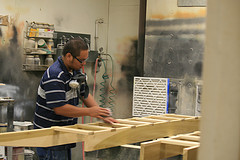 |
| Quimby Workshops |
 In late June I had the wonderful opportunity to visit Quimby Pipe Organ's shops in person. In this article, I'll take you along with me as best I can on my time spent there alongside some of the most talented pipe organ craftsmen in the United States.
In late June I had the wonderful opportunity to visit Quimby Pipe Organ's shops in person. In this article, I'll take you along with me as best I can on my time spent there alongside some of the most talented pipe organ craftsmen in the United States.The Quimby Pipe Organ (QPO) facility comprises several structures in multiple locations throughout Warrensburg, Missouri. The main workshop facility and office are located just a couple of blocks away form the University campus and what I'll call "downtown" Warrensburg.
After flight and rental car delays, I finally made it to Warrensburg - arriving at the motel at 3.30 am (not the original plan!) After a few hours sleep, I arrived at their main workshop and office building and was greeted by Michael Quimby and got to meet most of his crew.
 |
| Some re-leathering is taking place on the work tables. |
 |
| Some of our tuning access ladders in the paint booth receiving a lacquer coat. |
 |
| One of the woodworkers busy on components for our instrument. |
 |
| Tim at work on the boot (or base) of one of our reed pipes. |
Then next day was one of the most fascinating of the whole trip (granted, in an extremely nerdy way!). I was able to spend the majority of the day with Tim Duchon, the Pipemaker. He works offsite from the Quimby shops, but nearby. I came to learn that Tim is one of a very few people crafting pipes by hand in this country. I also quickly gained enormous respect for his skill (just like the rest of the QPO crew) and his mastery of his craft.
 |
| One of the large cutting machines used to cut sheet metal down to size. |
While I was visiting, he was making some pipes for one of our reed stops that need to be replaced. The walls of his workshop are filled with templates, forms, and many handmade tools for every conceivable type and size of pipe. In the center of the room is a large worktable where the pipes are rolled out.
 |
| Sheet metal being beaten around the form for a small treble pipe. |
After cutting, the sheet metal is bent around a form to make the basic shape of the pipe. This is done by hand whether the pipe is only a few inches in length or over 16 feet!
 |
| Two reed pipes ready for soldering. Mine is on the left. Not too bad for a first attempt! |
After further preparation work and soldering the seam closed (a task I was not able to get very good at....) we end up with completed basic pipe lengths. These will still need to have the reed assembly made and attached and then cleaned and finished in a lacquer coat.
The next day was my opportunity to watch the voicing process of reed pipes up close and personal. This was the perfect complement to spending the previous day working with the pipe maker. The voicing of reed pipes is one of the most mysterious and painstakingly meticulous arts in the realm of organ building.
 |
| Some reed pipes on the work table. These will be some of the new pipes for the 4' Clarion stop on the Swell division of our organ. |
 |
| Eric Johnson unpacking a rank of reed pipes to set up in the voicing room. |
When the process of voicing begins, the pipes have already been thoroughly cleaned and inspected for any flaws, and necessary repairs made by the pipemaker. After setting up a rank of reed pipes in the voicing room, Eric goes through and listens to each one, carefully analyzing many factors - its tone quality, volume, rate of speech, just to name a few.
One of the most fascinating steps to watch in the process was the work on what is called the "tongue". (This is the part of the reed assembly that actually vibrates, just like in an orchestral reed such as a clarinet or oboe, creating the reedy tone for the particular stop). These are all formed by hand from brass and range in size from several inches long to quite small, depending on the pitch of the pipe it will be used in. He then polishes and sets the curve (a slight bend) in each one by hand.
 |
| A close-up of the boot of a reed pipe on the worktable. The tongue is the small piece of brass laying on the table surface before being worked by Eric Johnson. |
Throughout the course of its history, the people of St Paul's have always been proud of its music program and desired the best organ possible, even from day one. This is evident in looking at the lineage of the St Paul's Memorial Organ from its beginning as a small, 2-maunual instrument by the venerable Hook and Hastings Organ Co in 1887 through its move to the present site and its major expansion and rebuilding by the Aeolian-Skinner Organ Co in 1969.
 |
| One of our reed stops set up in the voicing room. |
After my first-hand experience in Warrensburg I can say without hesitation that this tradition of obtaining the best of the best will be carried on, if not improved upon, in the present project by this amazing group of artisans that makes up the Quimby Pipe Organ Co.
Martin Green , Canon for Music

No comments:
Post a Comment